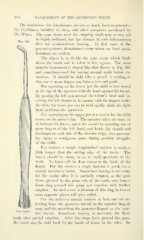Page 666 - My FlipBook
P. 666
664 MANAGEMENT OF THE DECIDUOUS TEETH. —
The indications for interference are not so niucli local as general
the fretfnlness, inability to sleep, and other symptoms mentioned by
Dr. White. The gum tissue over the erupting tooth may or may not
be highly inflamed, but the absence of such infianunation
Fio. 591.
does not contraindicate lancing. In fact some of the
gravest systemic disturbances occur where no local mani-
festations are evident.
The object is to divide the gum tissue which binds
down the tooth and to allow it free egress. The most
suitable instrument is shaped like that shown in Fig. 591
and sometimes used for lancing around teeth before ex-
traction. It should be held like a pencil in writing, so
that one or more fingers can form a rest and guide.
For operating on the lower jaw the child is best seated
in the lap of the operator with the head against his breast.
By passing the left arm around the infant's head and in-
serting the left thumb in its mouth with the fingers under
the chin, the lower jaw can be held rigidly while the right
hand performs the oj)eration.
For operating on the upper jaw it is best to lay the child
across on the nurse's lap. The operator takes the head on
or between his knees, opens the mouth by inserting one or
more fingers of the left hand, and holds the thumb and
forefinger on each side of the alveolar ridge, thus prevent-
ing injury to contiguous parts during possible struggles
of the child.
For incisors a simple longitudinal incision is made, a
little longer than the cutting edge of the tooth. The
lancet should be sharp, so as to easily penetrate to the
tooth. No harm will be done except to the blade of the
lancet. For the canines a single incision is good, but a
crucial incision is better. Sometimes lancing is necessary
for the canine after it is partially erupted, as the gum
tissue, pierced by the point only of the tooth, may form a
dense ring around this point and interfere with further
eruption. In such a case a division of this ring in two or
more opposite places will give relief.
For the molars a crucial incision is best, one cut ex-
tending from the posterior buccal to the anterior lingual
cusp, and the next from the posterior lingual to the ante-
Gum lancet.
rior buccal. Sometimes lancing is necessary for these
teeth after partial eruption. After the cusps have pierced the gum,
the tooth may be held back by the bands of tissue in the sulci. In


